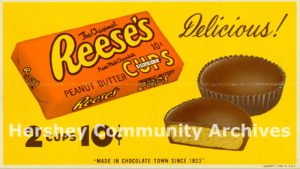Great Things Sometimes Start Small: H.B. Reese and the Reese Candy Company

Reese’s Peanut Butter Cups are one of the United States’ best loved candies. First introduced around 1928, the PB cups were not a stand-alone treat, but were marketed as part of an assortment of candies that you could buy by the weight.
They were named for their creator, Harry Burnett Reese. Unlike Milton Hershey, it was not obvious that Harry Reese was destined to become a confectioner. His background included stints as a farmer, dairy farmer, fish hatchery manager and factory worker. All these varied jobs resulted from Reese’s efforts to support his rapidly growing family. The jobs took him from York County to Ditchley, Virginia back to York County and then to New Freedom, Pennsylvania and finally to Hershey to work as a dairy farmer for Milton Hershey. None of these jobs prepared him for his future success.
But Harry Reese was impressed with Milton Hershey and the success Mr. Hershey had achieved with the Hershey Chocolate Company. Needing to support his family, Reese started making candy in his kitchen at night and marketing it around town and wherever he thought there might be customers. The first years were challenging and offered little promise of his future success.
The Archives’ oral history collections contains interviews with a number of H.B. Reese’s children as well as workers. His oldest daughter, Mary Elizabeth Reese Pearson, shared her memories of her father’s first efforts at candy making. Born in 1901, Mary was old enough to vividly remember those early years.
Interviewer: Right. Tell me about the time frame when he started to make the hard candy.
Pearson: Oh. Well, that was in 1919, the very first thing. He met an old man by the name of Mr. Bender up in Harrisburg at a market, where, you know, people bring in candies and things. And Mr. Bender gave him the recipe for these hard candies and he started making them, shipping them out by the barrel. It wasn’t long that he found his business wasn’t succeeding because the candy was sticking. It wasn’t holding up, see. That failed.
Interviewer: What did he try next?
Pearson: I think maybe he tried different things, but the main–the one big thing he was doing when I was at Temple University in 1920 to ’22 was a bar called–he called a Lizzy Bar. It was a chocolate bar, and I don’t know who gave him the recipe for the chocolate, but it started to sugar, see. So that bar went off the market.
Interviewer: It was named after you?
Pearson: Uh-huh. It was named after me. Because my roommate in those days called me Lizzy Bar. [Laughter] And he’d send me boxes of this candy. It was wrapped in a very beige-looking background with brown printing.
Then I think after that, most of his–oh. He was making another coconut caramel bar that was very popular for a while. Some man had given him the recipe for this coconut caramel, and the coconut was fresh coconuts–grated! He didn’t have a factory then; he just had a kitchen. So Poppy would go around three o’clock in the morning and start opening coconuts, fresh coconuts, and had them all peeled and ground, ready to make this coconut caramel candy. In the summertime, he would shape it in bars, see, and roll it in coconut, and take a whole carload [read “automobile”] of it over to Mount Gretna, where the government had a lot of soldiers over there, spending the summer over there at Mount Gretna. So then in the wintertime, he would cover it with chocolate, see, and sell it. So that was his third thing that was keeping him that he wasn’t completely out of business, see. He was still doing something.
So then I don’t know what year he started making all the different sort of candies and absolutely every center of that candy was delicious. He had dates that he– It was like a sausage grinder thing. The dates would go in there and they’d come out, and something would cut them off in little pieces. I was coating candies in those days, and if we were coating dates, they’d all be little cut-up pieces, and [we would] lay it in the Hershey’s chocolate, see. He always used Mr. Hershey’s coating, see.
And then that candy was put into these little tiny round cups and went out as assorted. So one day we’d make coated dates, the next day we’d make–he learned how to make a wonderful fondant, see. Delicious fondant. That’s how he made all these different assorted candies, see. I can’t tell you how many were in the box, but the box–it all went out wholesale, five-pound box for $1.29, to mostly big stores like Bon Tons and stores in Lancaster, and they would sell it out by the quarter and half-pound.
The business had a lot of ups and downs until H.B. Reese decided to concentrate on making peanut butter cups starting about 1941. You can read the whole story here. Just make sure you have some Reese’s peanut butter cups handy. You’re going to want some!